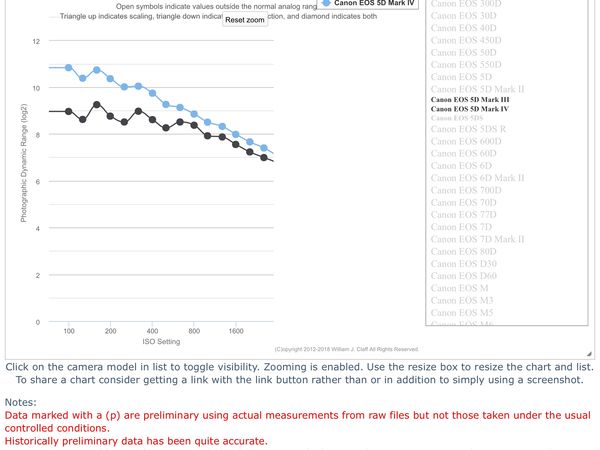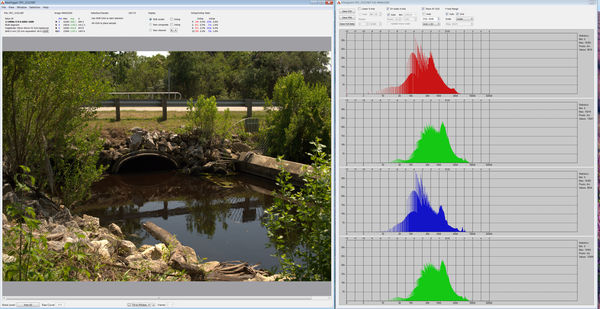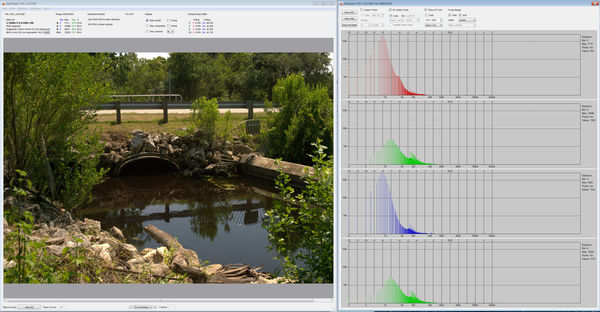ISO-less exposure
May 11, 2018 10:25:13 #
CatMarley wrote:
In the tested cameras that yielded higher noise with the underexposure, what you have revealed is that analogue amplification of the signal in those cameras is less noisy than the digital amplification. Future developments of software and firmware may equalize or reverse that situation. In any case, just one more useful tool.
Actually to fix it is just simply increase number of bits in the RAW file. Doing so would require faster memory cards, faster processor and faster A/D converter otherwise the frame rate would go down.
May 11, 2018 10:27:25 #
CatMarley wrote:
... what you have revealed is that analogue amplification of the signal in those cameras is less noisy than the digital amplification. ...
Take a look at my post above. You can't digitally amplify something that was never recorded in the first place.
What my example shows is that, having too few bits representing the darker colors, leads to a form of banding at the pixel level.
That's pretty much what BebuLamar was saying back on page 2. You only need to reword his statement slightly to read, "When the RAW files are down to only 8 bit you will get the posterization effect when you increase brightness in post."
May 11, 2018 10:30:06 #
BebuLamar wrote:
Actually to fix it is just simply increase number of bits in the RAW file. Doing so would require faster memory cards, faster processor and faster A/D converter otherwise the frame rate would go down.
Some cameras already record in 16-bit raw mode, just not mainstream models from Nikon or Canon.
May 11, 2018 10:35:55 #
selmslie wrote:
Take a look at url=http://www.uglyhedgehog.com/t-... (show quote)
Why shoot compressed raw files? Kind of defeats the purpose. Coulda, shoulda, woulda, games are sort of beyond the discussion. And again, NOBODY has applied the idea to recovering blown highlights. Detail exists only when there are shadows, and whiteout is featureless. You cannot amplify nothing. So continuing to restate that as an argument is really senseless.
May 11, 2018 10:41:05 #
CatMarley wrote:
Why shoot compressed raw files? Kind of defeats the purpose. Coulda, shoulda, woulda, games are sort of beyond the discussion. And again, NOBODY has applied the idea to recovering blown highlights. Detail exists only when there are shadows, and whiteout is featureless. You cannot amplify nothing. So continuing to restate that as an argument is really senseless.
Nothing is compressed in the shadows of the raw file.
The compression takes place in the upper regions where, for example, you don't need 8000 different values for the brightest stop or 4000 different values for the next darker stop.
If you look at the ISO 100 version in my post, the brightest values are around a value of about 400. That's less than 2^9. In other words, there are only 9 bits used.
The darker portions 5 stops down are at around 2^4=16, only 4 bits used. That's where the banding and degradation is happening.
May 11, 2018 11:05:19 #
BebuLamar wrote:
Actually to fix it is just simply increase number of bits in the RAW file. Doing so would require faster memory cards, faster processor and faster A/D converter otherwise the frame rate would go down.
Now that camera manufacturers have cooled their romance with the megapixel, maybe the faster processor and A/D converter and higher bit counts will evolve. Cameras will be able to capture the same dynamic range as the eye. I think the movement is bound to be away from the analog and toward the digital solution.
May 11, 2018 11:06:51 #
drklrd wrote:
Usually my Nikon D7200 on auto ISO sets the ISO to... (show quote)
You could use Exposure Compensation to underexpose and thereby force the camera to go to a lower ISO. But in some ways that might be too much of a hassle.
May 11, 2018 11:32:11 #
CatMarley wrote:
Now that camera manufacturers have cooled their romance with the megapixel, maybe the faster processor and A/D converter and higher bit counts will evolve. Cameras will be able to capture the same dynamic range as the eye. I think the movement is bound to be away from the analog and toward the digital solution.
It's not the A/D or the processor, it's the sensitivity and noise of the sensor. If the sensor were more sensitive and "quiter", amplification would not be required, only attenuation, which is essentially less noisey. The A/D can already handle 16 bits and so can the processor, and there are higher resolution A/Ds readily available - the limiting factor is the sensor.
Since the human eye is adaptive with both high light and low light sensors (cone and rod vision), the DR is between 16 and 20 stops total depending on whose tests you believe, so we're still a long way away with our current DRs of 11-12 steps max.
May 11, 2018 11:51:56 #
TriX wrote:
It's not the A/D or the processor, it's the sensit... (show quote)
Dynamic range is related to the signal to noise ratio of the sensor but ISO Invariance (or as Cat say ISO-less) is the effect of converting the analog voltage from the sensor to more bits than needed for a smooth tonal rendering.
May 11, 2018 12:20:03 #
BebuLamar wrote:
Dynamic range is related to the signal to noise ratio of the sensor but ISO Invariance (or as Cat say ISO-less) is the effect of converting the analog voltage from the sensor to more bits than needed for a smooth tonal rendering.
Well, whether it is “more bits than needed” is debatable. Again, if everyone agrees that 8-9 bits is adequate for smooth tonal rendering (and I don’tt think this is by any means universally agreed), then why bother with 16 bit ADCs, 16 bit PP. etc.? Let’s just standardize on 8 bits. Of course that will also limit the DR to 8 stops or ~48 dB S/N max. DR is related to S/N but the primary noise source in the signal chain is the sensor - again I refer to the paper I mentioned in a previous post. Bottom line, it's the sensor that primarily drives S/N and DR, with a smaller contribution from amplification and digitization uncertainty (that shows up as noise) from the ADC, not SW algorithms. It’s interesting and informative to look at the DR curve of a couple of Canon bodies (see below). Those ”jagged” areas in the DR curve are where the amplifier gain changes. notice that it is flat after ~ISO 800 when the amplifier gain is maxed and all further ISO changes are due to SW multiplication, hence Scotty’s previous statement that Even Canons are “ISO invariant” beyound ISO 800. What’s occurring is that in those cases between steps, where the sensor output is lower, but the gain hasn’t changed yet, is that the DR (and S/N) drops.
And BTW, less everyone gets carried away with the concept of always shooting at base ISO, let’s remember that in addition to the lost data resolution, by no means are the majority of cameras in use ISO invariant, especially below ISO 800-1000. In particular, most Canons (which comprise a substantial portion of DSLRs in service) are not ISO invarient, especially below ISO 1,000, and as most experienced Canon shooters know, underexposing and bringing up in post is a recipe for more noise.

May 11, 2018 12:20:49 #
TriX wrote:
It's not the A/D or the processor, it's the sensitivity and noise of the sensor. ...
It's both.
Here is another example of two images captured with the same exposure, 1/200 sec @ f/9, one at ISO 1600 and the other at ISO 100. Since the exposure was the same, so was the S/N ratio and therefor the analog voltages recorded at the sensor were the same before they were read and converted into values for the raw file.
The thumbnail images look pretty much the same but if you download them and look closer you will see why the ISO 100 version cannot be adjusted to produce the same final result.
About 7 stops down from the brightest value you will see raw values of around 8 (3 bits) in the ISO 100 version.
But in the ISO 1600 version the raw values are 16x as high, around 128 or 7 bits.
May 11, 2018 12:31:12 #
TriX wrote:
Well, whether it is “more bits than needed” is d... (show quote)
Let say 8 bits is enough for smooth tonal rendering and you capture the RAW at ISO1600 and the image is good. Now if you set it for ISO200 and when you boost the brightness in ACR you ended up with only 5 bits and that is no longer sufficient for smooth tonal rendering.
May 11, 2018 12:49:43 #
BebuLamar wrote:
Let say 8 bits is enough for smooth tonal rendering and you capture the RAW at ISO1600 and the image is good. Now if you set it for ISO200 and when you boost the brightness in ACR you ended up with only 5 bits and that is no longer sufficient for smooth tonal rendering.
Completely agree.
May 11, 2018 12:55:19 #
I guess after all the folderol in these 10+ pages, my question is why do people continue to try to violate known photographic principles? There's a saying which goes something like this, "Just because you can do something, doesn't mean you should do that something".
I've seen numerous posts on this site wherein people continually try to show that they can produce a "good" photograph but don't need to do this or that, which are accepted photographic rules regarding exposure. Sure, one may underexpose and push in processing. Doing so will increase visible grain in film and digital grain in digital images. Other than saying "I did it" what's the purpose?
In some cases, it's just lack of knowledge of the facts. In some cases, it's to bloviate about how the accepted rules don't apply to what they do. Some experimentation is a good thing. However, one needs to accept that the result of the experiment has flaws. Hopefully, some of this reasoning doesn't get accepted by those who are new to photography. Bad habits are hard to break.
--Bob
I've seen numerous posts on this site wherein people continually try to show that they can produce a "good" photograph but don't need to do this or that, which are accepted photographic rules regarding exposure. Sure, one may underexpose and push in processing. Doing so will increase visible grain in film and digital grain in digital images. Other than saying "I did it" what's the purpose?
In some cases, it's just lack of knowledge of the facts. In some cases, it's to bloviate about how the accepted rules don't apply to what they do. Some experimentation is a good thing. However, one needs to accept that the result of the experiment has flaws. Hopefully, some of this reasoning doesn't get accepted by those who are new to photography. Bad habits are hard to break.
--Bob
CatMarley wrote:
I was unaware until recently that the camera expos... (show quote)
May 11, 2018 13:58:50 #
rmalarz wrote:
I guess after all the folderol in these 10+ pages, my question is why do people continue to try to violate known photographic principles? There's a saying which goes something like this, "Just because you can do something, doesn't mean you should do that something". ...
It's always nice to explore the limits, both low and high. That's the only way you can be sure how far is too far.
My last two post comparing a "normally" exposed subject compared to one with a lower ISO were both initially metered using Multi-segment metering at ISO 1600 with the manual exposure set to center the meter at EV+0.
In the image of the culvert, the combined exposure and ISO setting works out to about 13.333 or about 1.33 stops below Sunny 16 (14.67). However you can see from the histograms that the green channels closely approach (within less than a 1/2 stop) the 14-bit raw limit of about 16000.
The image of the fireplace was exposed using the same method at ISO 1600 but the DR was clearly narrower and the green channels only reached a level of about 5600 or a 1.5 stops below the limit even though there were a few specular highlights that went past 16000.
So there is no sillier to explore the lower limits of the captured DR than it is to explore the upper limits by employing ETTR/EBTR. Both methods can be regarded as extreme and risky but the upper limit is a hard limit. The lower limit is more subtle.
If you want to reply, then register here. Registration is free and your account is created instantly, so you can post right away.






